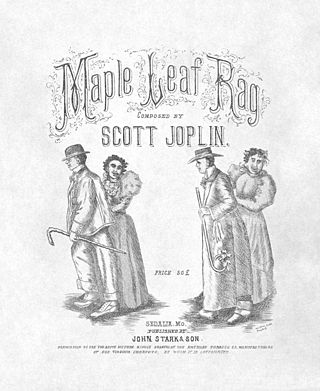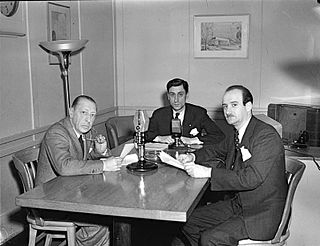Related Research Articles
Ragtime, also spelled rag-time or rag time, is a musical style that had its peak from the 1890s to 1910s. Its cardinal trait is its syncopated or "ragged" rhythm. Ragtime was popularized during the early 20th century by composers such as Scott Joplin, James Scott and Joseph Lamb. Ragtime pieces are typically composed for and performed on piano, though the genre has been adapted for a variety of instruments and styles.

Scott Joplin was an American composer and pianist. Dubbed the "King of Ragtime", he composed more than 40 ragtime pieces, one ragtime ballet, and two operas. One of his first and most popular pieces, the "Maple Leaf Rag", became the genre's first and most influential hit, later being recognized as the quintessential rag. Joplin considered ragtime to be a form of classical music meant to be played in concert halls and largely disdained the performance of ragtime as honky tonk music most common in saloons.

Igor Fyodorovich Stravinsky was a Russian composer and conductor with French citizenship and United States citizenship. He is widely considered one of the most important and influential composers of the 20th century and a pivotal figure in modernist music.

Joseph Francis Lamb was an American composer of ragtime music. Lamb, of Irish descent, was the only non-African American of the "Big Three" composers of classical ragtime, the other two being Scott Joplin and James Scott. The ragtime of Joseph Lamb ranges from standard popular fare to complex and highly engaging. His use of long phrases was influenced by classical works he had learned from his sister and others while growing up, but his sense of structure was potentially derived from his study of Joplin's piano rags. By the time he added some polish to his later works in the 1950s, Lamb had mastered the classic rag genre in a way that almost no other composer was able to approach at that time, and continued to play it passably as well, as evidenced by at least two separate recordings done in his home, as well as a few recorded interviews.

The "Maple Leaf Rag" is an early ragtime musical composition for piano composed by Scott Joplin. It was one of Joplin's early works, becoming the model for ragtime compositions by subsequent composers. It is one of the most famous of all ragtime pieces. Its success led to Joplin being dubbed the "King of Ragtime" by his contemporaries. The piece gave Joplin a steady if unspectacular income for the rest of his life.

Boris Vladimirovich Asafyev was a Russian and Soviet composer, writer, musicologist, musical critic and one of founders of Soviet musicology. He is the dedicatee of Prokofiev's First Symphony. He was born in Saint Petersburg.
The Wedding, or Svadebka (Russian: Свадебка), is a Russian-language ballet-cantata by Igor Stravinsky scored unusually for four vocal soloists, chorus, percussion and four pianos. Dedicating the work to impresario Sergei Diaghilev, the composer described it in French as "choreographed Russian scenes with singing and music" [sic], and it remains known by its French name of Les noces despite being Russian.

Renard: histoire burlesque chantée et jouée, or The Fox: burlesque tale sung and played, is a chamber opera-ballet for four male voices and 16 instrumentalists written in 1916 by Igor Stravinsky. Its original Russian text, by the composer, derives from a folk tale as collected by Alexander Afanasyev — but the piece has no name in Russian, being titled generically instead as Байка про лису, петуха, кота да барана, or Tale of the Fox, the Cock, the Cat and the Ram. The premiere took place in a French translation in Paris on 18 May 1922. Duration: 16–17 minutes.

Trois mouvements de Petrouchka or Three Movements from Petrushka is an arrangement for piano of music from the ballet Petrushka by the composer Igor Stravinsky for the pianist Arthur Rubinstein.

"Magnetic Rag" is a 1914 ragtime piano composition by American composer Scott Joplin. It is significant for being the last rag which Joplin published in his lifetime, three years before his death in 1917. It is also unique in form and in some of the musical techniques employed in the composition.

Igor Stravinsky wrote the Ebony Concerto in 1945 for the Woody Herman band known as the First Herd. It is one in a series of compositions commissioned by the bandleader/clarinetist featuring solo clarinet, and the score is dedicated to him. It was first performed on March 25, 1946 in Carnegie Hall in New York City, by Woody Herman's Band, conducted by Walter Hendl.
Sonata for Two Pianos is a composition by Russian composer Igor Stravinsky, premiered in 1944 by Richard Johnston and Nadia Boulanger. First conceived as a solo work, Stravinsky needed to write it for four hands to voice all four melodic lines clearly. It is considered one of Stravinsky's most important compositions for two solo pianos, together with Concerto for Two Pianos.
Serenade in A is a work for solo piano by Russian composer Igor Stravinsky. Completed on September 9, 1925, in Vienna and published by Boosey & Hawkes, it resulted from his signing his first gramophone recording contract, for Brunswick, and was written so that each movement could fit on one side of a 78 rpm record. The dedicatee was Stravinsky's wife Yekaterina.
The Piano Sonata, sometimes also referred to as Sonata for Piano or in its original French form, Sonate pour piano, is a 1924 piano sonata by Russian expatriate composer Igor Stravinsky.
Scherzo à la russe is a composition by Russian expatriate composer Igor Stravinsky. It was initially published by Chappell & Co. in 1945 and premiered in March 1946 by the San Francisco Symphony Orchestra, conducted by the composer himself. It was later published by Boosey & Hawkes.
Three Pieces for Solo Clarinet is a solo instrumental work by Igor Stravinsky. The work was composed in 1918. It was published in 1919, shortly after the completion of his Suite from L'Histoire du Soldat, as a thank-you gift to the philanthropist and arts patron Werner Reinhart, who was also an amateur clarinetist. The Three Pieces is perhaps the most well-known work for unaccompanied clarinet in the repertoire. It is also notable for being one of the few clarinet solo pieces that calls for clarinets in both B♭ and A.

Scherzo, sometimes also referred to as Scherzo in G minor, is one of Igor Stravinsky's earliest works for piano. It was composed in 1902.

Bluebird Pas de Deux is a 1941 arrangement for chamber orchestra of a short section of Pyotr Ilyich Tchaikovsky's The Sleeping Beauty composed by Igor Stravinsky. It was used in Lucia Chase's Bluebird ballet.

The Two Sketches for a Sonata are parts of an unfinished piano work by Igor Stravinsky. He dated the manuscript 1966 and it is composed in his late twelve-tone style. It is his last attempt at original composition.
References
- 1 2 3 Allmusic. "Piano Rag Music" (Archive from 8 October 2007).